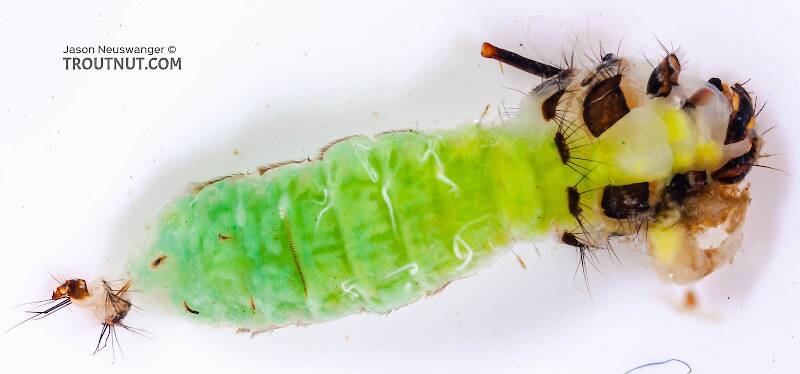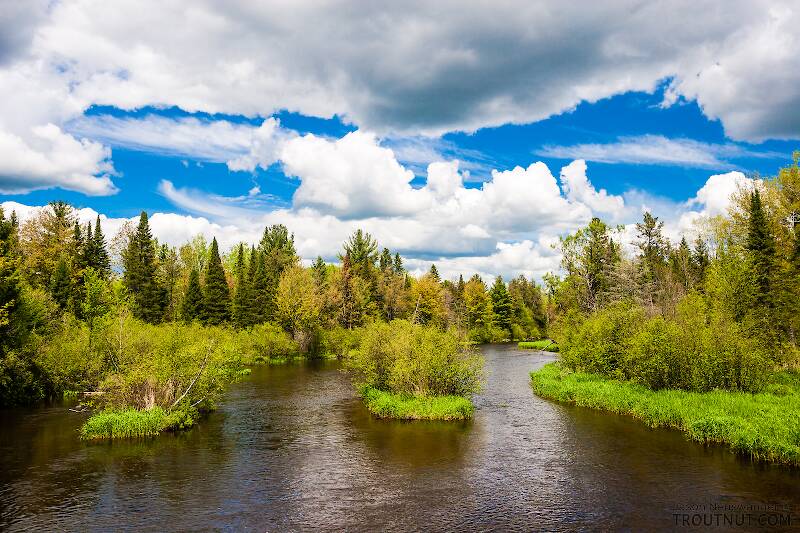
Blue-winged Olives
Baetis
Tiny Baetis mayflies are perhaps the most commonly encountered and imitated by anglers on all American trout streams due to their great abundance, widespread distribution, and trout-friendly emergence habits.
Featured on the forum

I was not fishing, but happened to be at an unrelated social event on a hill above this tiny creek (which I never even saw) when this stonefly flew by me. I assume it came from there. Some key characteristics are tricky to follow, but process of elimination ultimately led me to Sweltsa borealis. It is reassuringly similar to this specimen posted by Bob Newell years ago. It is also so strikingly similar to this nymph from the same river system that I'm comfortable identifying that nymph from this adult. I was especially pleased with the closeup photo of four mites parasitizing this one.

Troutnut is a project started in 2003 by salmonid ecologist Jason "Troutnut" Neuswanger to help anglers and
fly tyers unabashedly embrace the entomological side of the sport. Learn more about Troutnut or
support the project for an enhanced experience here.

The green blob contained in this case is a pupa in the early stages of transformation from larva to the final stage we generally picture and imitate. This specimen and several like it were fixed to a rock I picked up, and each one had the front of its case sealed off, protecting the helpless pupa from predation. It's neat to see the insect part-way through such a radical transformation.
It was very hard to extract this thing from its case, so there's a bit of extra goo near the head from where I accidentally punctured it.
It was very hard to extract this thing from its case, so there's a bit of extra goo near the head from where I accidentally punctured it.
CaseyP on Dec 18, 2009December 18th, 2009, 8:37 am EST
tying for the grannom hatch on the Little Juniata. have a couple of standards, but just can't resist fiddling a bit:
do the grannom larvae in their cases hold onto the rocks with little sticky filaments which might be duplicated with a few fibers of CDC, or do they hold on with their legs sticking out which can be duplicated with hackle, or do they not hold on at all?
do the grannom larvae in their cases hold onto the rocks with little sticky filaments which might be duplicated with a few fibers of CDC, or do they hold on with their legs sticking out which can be duplicated with hackle, or do they not hold on at all?
"You can observe a lot by watching." Yogi Berra
Tilman on Dec 18, 2009December 18th, 2009, 11:01 am EST
I´m interested in how you will attempt to imitate this kind of body.
Glass beads would do a good job, but are very heavy, if the size is too big. (i have some very small ones, for a size 14-16 nymph hook)
I´d like to see a photo of your fly, when you are done.
Glass beads would do a good job, but are very heavy, if the size is too big. (i have some very small ones, for a size 14-16 nymph hook)
I´d like to see a photo of your fly, when you are done.
CaseyP on Dec 18, 2009December 18th, 2009, 11:38 am EST
it's not fancy or intricate--peacock Ice Dub for a body, bright green thread, and a black tungsten bead. i've caught fish on size 12 nymph hooks and size 16 wet hooks.
i'll post a photo over on the photo place after the holidays.
i've tied them in Krienik braid as well, but haven't fished them; one of my gurus said the fuzzy, buggy one would do better. next spring i'll do one of my patented tests: tie one of each on a leader with two tags and see what works best. did that once with shad darts and indeed, that silly one with the plain red cone head out-caught the the others by a mile.
i'll post a photo over on the photo place after the holidays.
i've tied them in Krienik braid as well, but haven't fished them; one of my gurus said the fuzzy, buggy one would do better. next spring i'll do one of my patented tests: tie one of each on a leader with two tags and see what works best. did that once with shad darts and indeed, that silly one with the plain red cone head out-caught the the others by a mile.
"You can observe a lot by watching." Yogi Berra
Creno on Dec 18, 2009December 18th, 2009, 3:07 pm EST
Brachycentrus larvae usually glue the leading edge of the case to the substrate of choice - rock, wood, another Brachycentrus case,etc. There are some great photos of this, and lots of other neat critters and stuff, on Joe Giersch's site: drunelladesigns.com. check it out! Joe is a great guy who knows an awful lot about alot of aquatic insects.
creno
creno
CaseyP on Dec 19, 2009December 19th, 2009, 1:45 am EST
gee, thanks, Creno! indeed, pictures are worth so much more than mere words...
"You can observe a lot by watching." Yogi Berra
Lastchance on Dec 19, 2009December 19th, 2009, 2:27 am EST
After looking again at Jason's photos of the grannom caddis, I wonder, don't we tie these pupas too dark? I know the emergers are tied with dark bodies imitated with peacock herl, etc.
Bruce
Bruce
LittleJ on Dec 19, 2009December 19th, 2009, 8:25 am EST
Bruce,
I believe when they emerge from the case they are a darker color. However, a Tapered pheasant tail case w/ a light green sparkle yarn "larva" works great in the days leading up to this hatch.
jeff
I believe when they emerge from the case they are a darker color. However, a Tapered pheasant tail case w/ a light green sparkle yarn "larva" works great in the days leading up to this hatch.
jeff
CaseyP on Dec 19, 2009December 19th, 2009, 12:09 pm EST
I know the emergers are tied with dark bodies imitated with peacock herl, etc.--Bruce
well, silly me! all along i thought the peacock/furnace fly was imitating the cased larva come adrift in the process of pupating. hence my addition of bright green thread.
"You can observe a lot by watching." Yogi Berra
Lastchance on Dec 20, 2009December 20th, 2009, 2:01 am EST
Hi CaseyP: I may be wrong about that, but when I was learning to fly fish about 25 years ago that's what I was told. I fished a similar wet fly we called "Bait" because during the caddis hatch it caught so many fish on the deadrift and the swing. It was actually brown hackle and peacock.
Merry Christmas,
Bruce
Merry Christmas,
Bruce
CaseyP on Dec 20, 2009December 20th, 2009, 7:11 am EST
Bruce, you must be right: the adults are black with tan speckled wings. the pupa we see in Jason's photos was still inside the case. it stands to reason that the pupa would be darker when it was ready to hatch into an adult. (but what has reason to do with any of this?)
if we just let the trout tell us what color things ought to be, we'd save a lot of speculation, and it seems to me you've done that. thanks for sharing! back to the tying table...;-)
if we just let the trout tell us what color things ought to be, we'd save a lot of speculation, and it seems to me you've done that. thanks for sharing! back to the tying table...;-)
"You can observe a lot by watching." Yogi Berra
LittleJ on Dec 20, 2009December 20th, 2009, 8:51 am EST
a peacock wet with a green tag works very well. The females are divers and the egg sac is about the color of the larva.
Quick Reply
Related Discussions
Topic
Replies
Last Reply
0
Mar 23, 2010
by Troutboomer
by Troutboomer
0
May 6, 2011
by Jtberez
by Jtberez
9
Apr 30, 2013
by Oldredbarn
by Oldredbarn


